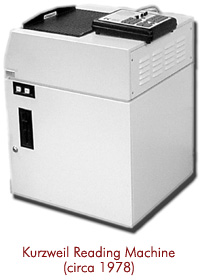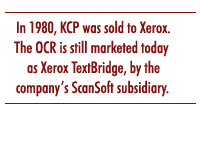|
In this excerpt from The Age of Spiritual Machines
(Viking, 1999), Ray Kurzweil recalls the creation of the world's first reading machine.
 In 1974,
computer programs that could recognize printed letters, called optical
character recognition (OCR), were capable of handling only one or two
specialized type styles. I founded Kurzweil Computer Products, Inc. that
year to develop the first OCR program that could recognize any style of
print, which we succeeded in doing later that year. So the question then
became, "What is it good for?" Like a lot of clever computer
software, it was a solution in search of a problem. In 1974,
computer programs that could recognize printed letters, called optical
character recognition (OCR), were capable of handling only one or two
specialized type styles. I founded Kurzweil Computer Products, Inc. that
year to develop the first OCR program that could recognize any style of
print, which we succeeded in doing later that year. So the question then
became, "What is it good for?" Like a lot of clever computer
software, it was a solution in search of a problem.
I happened to sit next to a blind gentleman on a plane flight, and he
explained to me that the only real handicap that he experienced was his
inability to read ordinary printed material. It was clear that his visual
disability imparted no real handicap in either communicating or traveling.
So I had found the problem we were searching for - we could apply our
"omni-font" (any font) OCR technology to overcome this principal
handicap of blindness. We didn't have the ubiquitous scanners or text-to-speech
synthesizers that we do today, so we had to create these technologies
as well. By the end of 1975, we put together these three new technologies
we had invented - omni-font OCR, CCD (Charge Coupled Device) flat-bed
scanners, and text-to-speech synthesis to create the first print-to-speech
reading machine for the blind. The Kurzweil Reading Machine (KRM) was
able to read ordinary books, magazines, and other printed documents out
loud so that a blind person could read anything he wanted.
We announced the KRM in January of 1976, and it seemed to strike a chord.
All the evening network news programs carried the story, and Walter Cronkite
used the machine to read aloud his signature sign-off "And that's
the way it was, January 13, 1976."
Shortly after the announcement, I was invited onto the Today Show, which
was a little nerve wracking since we only had one working reading machine.
Sure enough, the machine stopped working a couple of hours before I was
scheduled to go on live national television.
Our chief engineer frantically took the machine apart, scattering pieces
of electronics and wires across the floor of the set. Frank Field, who
was going to interview me, walked by and asked if everything was okay.
"Sure Frank," I replied. "We're just making a few last
minute adjustments." Our chief engineer put the reading machine back
together, and still it didn't work. Finally, he used a time honored method
of repairing delicate electronic equipment and slammed the reading machine
against a table. From that moment, it worked just fine. Its live television
debut then proceeded without a hitch.
Stevie Wonder heard about our appearance on the Today Show, and decided
to check out the story himself. Our receptionist was skeptical that the
person on the other end of the line was really the legendary singer, but
she put the call through to me anyway. I invited him over, and he tried
out the machine. He beseeched us to provide him with his own reading machine,
so we turned the factory upside down to hurriedly finish up our first
production unit (we didn't want to give him the prototype we used on the
Today Show, as it still had a few battle scars). We showed Stevie how
to use it, and off he went in a taxi with his new reading machine by his
side.
We subsequently applied the scanning and omni-font OCR to commercial
uses such as entering data into data bases and into the emerging word
processing computers. New information services, such as Lexis (an on-line
legal research service) and Nexis (a news service) were built using the
Kurzweil Data Entry Machine to scan and recognize written documents.
In 1978, after years of scrambling to raise funds for our venture, we
were fortunate in attracting interest and investment from a big company:
Xerox. Most Xerox products transferred electronic information onto paper.
They saw the Kurzweil scanning and OCR technology as providing a bridge
back from the world of paper to the electronic world, so in 1980 they
bought the company. You can still buy the OCR we originally developed,
suitably updated - it's now called Xerox TextBridge, and continues as
a market leader.
|


|

![]()
